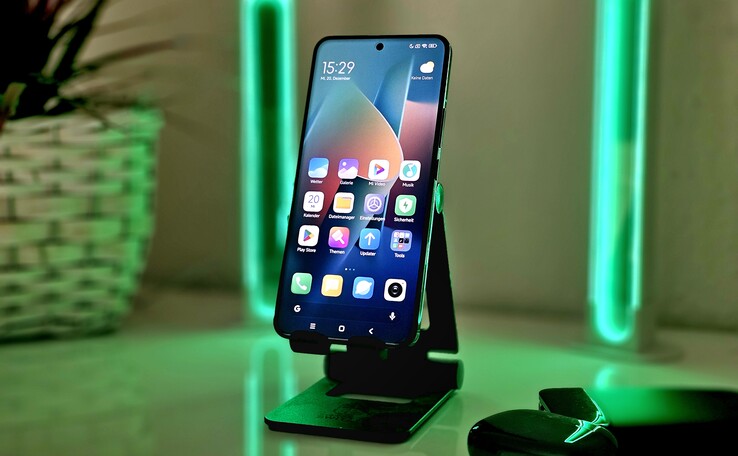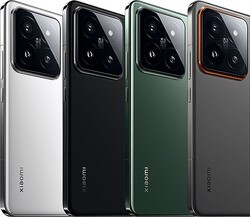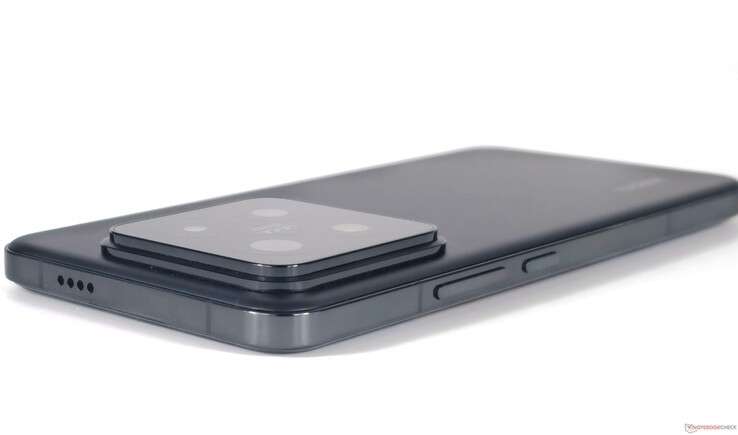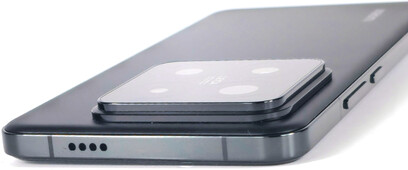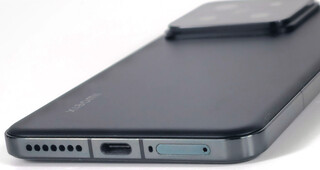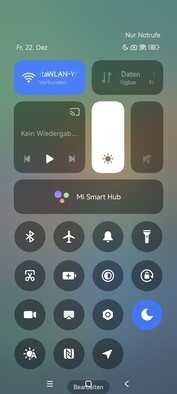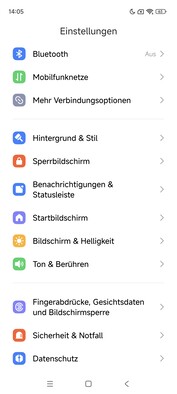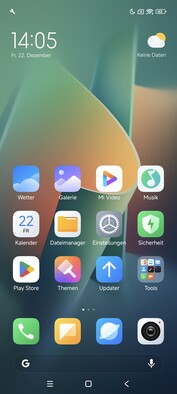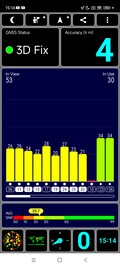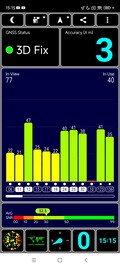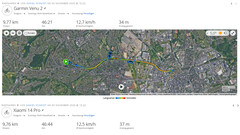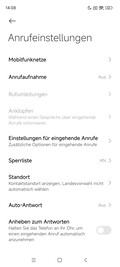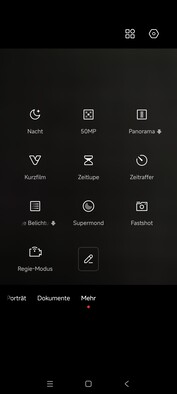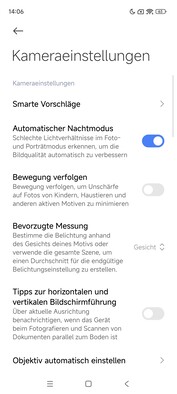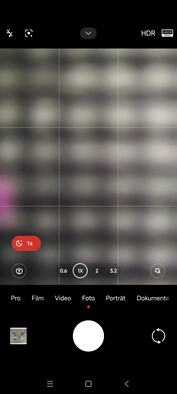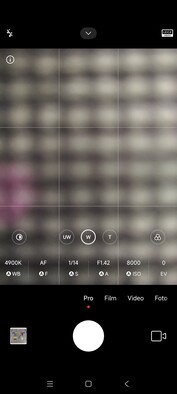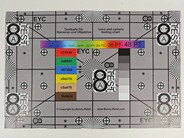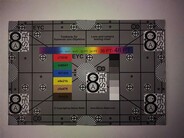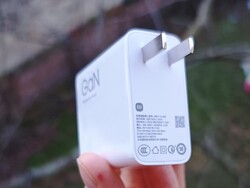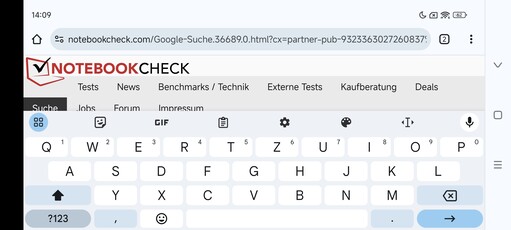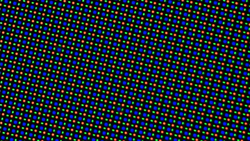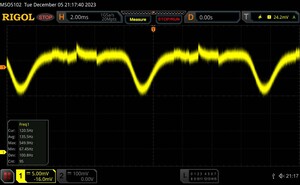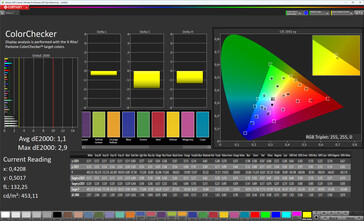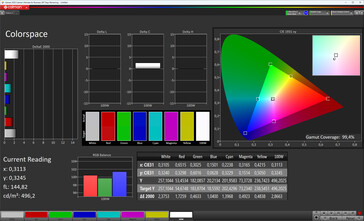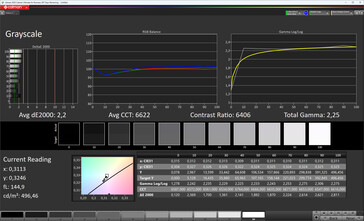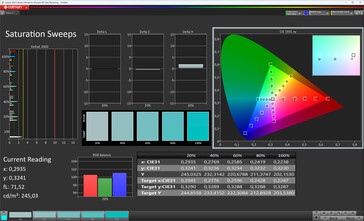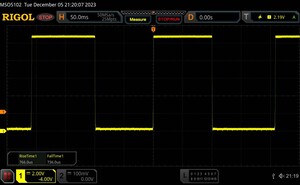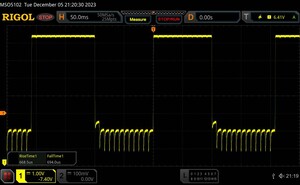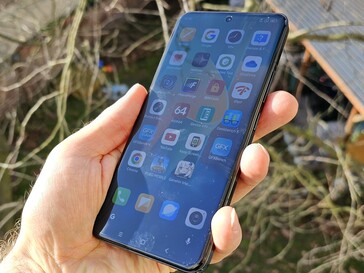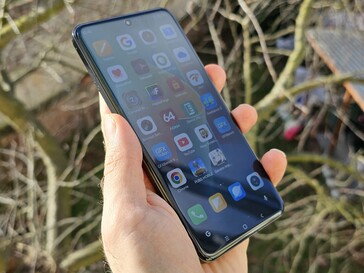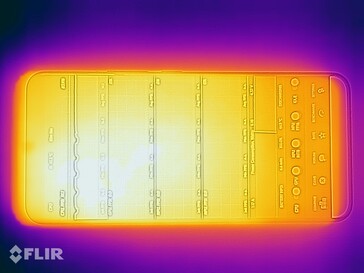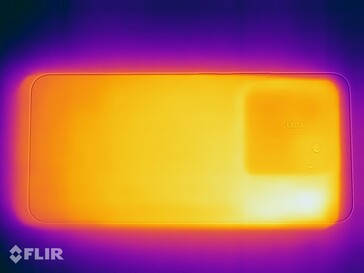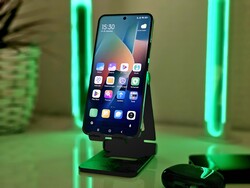小米 14 Pro 评测--配备出色显示屏的徕卡相机智能手机仍存在一些问题
小米 14 Pro 不仅在Android 智能手机中使用了目前最好的 SoC,还配备了 高通骁龙 8 代 3高通骁龙 8 代 3,而且与 13 Pro 相比,它还在相机系统方面做出了一些有趣的改变。 13 Pro.1英寸规格的索尼IMX989被1/1.31英寸规格的名为 "Light Hunter 900 "的新型图像传感器取代,后者可能来自Omnivision。.50 百万像素主相机的镜头采用可变光圈,允许使用最大 f/4.0 的光圈,使描绘的物体更具深度。相比之下 小米 13 Ultra相比,14 Pro 的光圈可以分几步打开。
小米 14 Pro 目前只在中国销售,尚不清楚是否会在欧洲市场推出全球版本。配备 12 GB 内存和 256 GB 闪存的基本版本的进口价格为 790 欧元(约合 839 美元)起。钛特别版的顶级型号配备 16 GB 内存和 1 TB 存储空间,售价约为 960 欧元(约合 1060 美元)。
潜在的竞争对手比较
Rating | Date | Model | Weight | Drive | Size | Resolution | Price |
|---|---|---|---|---|---|---|---|
| 89.4 % v7 (old) | 01 / 2024 | Xiaomi 14 Pro SD 8 Gen 3, Adreno 750 | 223 g | 256 GB UFS 4.0 Flash | 6.73" | 3200x1440 | |
| 90.3 % v7 (old) | 03 / 2023 | Samsung Galaxy S23+ SD 8 Gen 2 for Galaxy, Adreno 740 | 195 g | 256 GB UFS 4.0 Flash | 6.60" | 2340x1080 | |
| 89 % v7 (old) | 12 / 2023 | Google Pixel 8 Pro Tensor G3, Mali-G715 MP7 | 213 g | 128 GB UFS 3.1 Flash | 6.70" | 2992x1344 | |
| 89 % v7 (old) | 09 / 2023 | Sony Xperia 5 V SD 8 Gen 2, Adreno 740 | 182 g | 128 GB UFS 3.1 Flash | 6.10" | 2520x1080 | |
| 89.2 % v7 (old) | 03 / 2023 | Xiaomi 13 Pro SD 8 Gen 2, Adreno 740 | 229 g | 256 GB UFS 4.0 Flash | 6.73" | 3200x1440 |
手机壳 - 通过 IP 认证的小米智能手机
» Notebookcheck多媒体笔记本电脑Top 10排名
» Notebookcheck游戏笔记本电脑Top 10排名
» Notebookcheck低价办公/商务笔记本电脑Top 10排名
» Notebookcheck高端办公/商务笔记本电脑Top 10排名
» Notebookcheck工作站笔记本电脑Top 10排名
» Notebookcheck亚笔记本电脑Top 10排名
» Notebookcheck超级本产品Top 10排名
» Notebookcheck变形本产品Top 10排名
» Notebookcheck平板电脑Top 10排名
» Notebookcheck智能手机Top 10排名
» Notebookcheck评测过最出色的笔记本电脑屏幕
» Notebookcheck售价500欧元以下笔记本电脑Top 10排名
» Notebookcheck售价300欧元以下笔记本电脑Top 10排名
与前代产品相比,小米 14 Pro 最有趣的变化之一是采用了保护玻璃。小米放弃了康宁的大猩猩玻璃,而选择了自己的内部材料。这种名为小米陶瓷玻璃的保护玻璃可以提供特别高的防摔保护。据制造商称,它的防摔保护性能比 iPhone 15 Pro 的陶瓷防护玻璃高出 20%。 Apple iPhone 15 Pro.在保护方面,这家中国制造商目前的旗舰产品还提供了 IP68 认证的防水防尘保护壳。
这款手机壳有三种磨砂色以及磨砂钛金特别版(带钛金边框)可供选择。14 Pro 的做工质量达到了非常高的水平。小米智能手机的外形尺寸几乎与 13 Pro但制造商通过在 OLED 面板周围使用略微纤薄的边框,略微改善了显示屏与表面的比例。
小米 14 Pro 的显示屏现在采用了 "全方位液晶 "设计。这意味着面板的四个角和边缘都是圆形的,向下弯曲的弧度均匀,在使用滑动手势时感觉非常符合人体工程学。
设备 - 配备 USB 3.2 的小米 14 Pro
尽管由于没有红外爆破器或超宽带芯片,小米 14 Pro 仍不是最好中的最好,但这家中国制造商目前的旗舰产品总体上提供了非常好的设备,包括蓝牙 5.4、Miracast 和 NFC。
与前代产品相比,小米 14 Pro 现在终于加入了快速 USB 连接,根据规格说明,其运行速度为 USB 3.2(Gen.2),并支持 USB OTG 和有线显示输出。然而,在我们使用已连接的 M2.SSD 硬盘(三星 980 Pro)进行的拷贝测试中,本应非常快速的 USB 端口的传输速度仅为 311 MB/s。既没有可选的存储扩展,也没有音频接口。
软件 - 装有Android 14 的小米智能手机
小米 HyperOS 内核是 Linux 和自主开发的 Vela 系统的混合体,是首次在智能手机上使用。与 MIUI 用户界面相比,HyperOS 在视觉效果和菜单结构上有许多相似之处,这可能会让那些希望通过 HyperOS 获得基于Android 的全新操作系统的用户感到失望。不过,在日常操作中,HyperOS 仍然是一个优化得非常好的用户界面,其外观与早先的 MIUI 相比焕然一新--但软件的新开始看起来有所不同,即使在引擎盖下有一些优化和实现,如安全和数据隐私保护。
小米计划为 14 Pro 提供长达四年的软件更新,甚至还将提供长达一年的安全补丁--不过目前还不清楚每个季度会有多少更新。在我们测试期间,操作系统基于Android 14 和 2023 年 11 月的安全补丁级别。
我们从深圳贸易公司借来的测试机已经预装了新的 Xiaomi.eu 表面,包括访问 Play Store 和德语语言。不过,由于是制造商提供的,中文版既不支持谷歌应用,也不支持多种语言。因此,用户需要在这里自行安装 apk 文件,并满足于英文语言。
通信和全球导航卫星系统 - 配备 WiFi 7 的小米 14 Pro
当连接到家中的无线局域网时,小米智能手机提供了当前 WiFi 7 标准的最佳性能。使用我们的华硕 ROG Rapture GT-AXE11000 参考路由器,测试设备不仅显示出非常高而且相对稳定的传输速率,我们测得的最高传输速率接近 1,900 Mbit/s。
除了快速 WLAN 之外,小米 14 Pro 还采用了 5G 标准,不过它只提供 16 个 LTE 频段。中国版一般只提供较少的频段覆盖,不支持接入 LTE 频段 20。需要更多 4G 频率或四 GSM 的用户只能等待全球版本。
| Networking | |
| Xiaomi 14 Pro | |
| iperf3 receive AXE11000 | |
| iperf3 transmit AXE11000 | |
| iperf3 transmit AXE11000 6GHz | |
| iperf3 receive AXE11000 6GHz | |
| Samsung Galaxy S23+ | |
| iperf3 receive AXE11000 | |
| iperf3 transmit AXE11000 | |
| iperf3 transmit AXE11000 6GHz | |
| iperf3 receive AXE11000 6GHz | |
| Google Pixel 8 Pro | |
| iperf3 receive AXE11000 | |
| iperf3 transmit AXE11000 | |
| iperf3 transmit AXE11000 6GHz | |
| iperf3 receive AXE11000 6GHz | |
| Sony Xperia 5 V | |
| iperf3 receive AXE11000 | |
| iperf3 transmit AXE11000 | |
| Xiaomi 13 Pro | |
| iperf3 receive AXE11000 | |
| iperf3 transmit AXE11000 | |
| iperf3 transmit AXE11000 6GHz | |
| iperf3 receive AXE11000 6GHz | |
| Average of class Smartphone | |
| iperf3 receive AXE11000 | |
| iperf3 transmit AXE11000 | |
| iperf3 transmit AXE11000 6GHz | |
| iperf3 receive AXE11000 6GHz | |
电话功能和语音质量 - 配备双 SIM 卡的小米智能手机
小米 14 Pro 提供完整的双 SIM 卡功能,在 5G 网络中拥有两个 nano-SIM 卡插槽。在中国版的系统设置中,我们没有找到将 eSIM 卡集成到系统中的选项。由于 T 系列提供了 eSIM 功能,如果全球版本也支持该功能,我们也不会感到惊讶。
内置的三个麦克风能提供非常有吸引力的语音体验,不过一些较小的恼人噪音会稍有影响。使用听筒时,语音质量非常清晰,但声音仍可稍大一些。
摄像头 - 配备 OIS 的小米智能手机
与 前代14 Pro 的 3200 万像素自拍摄像头的分辨率保持不变,但这款高端智能手机现在终于支持 60 fps 的 4K 视频。尽管 14 Pro 仍然不是自拍专家,但照片质量也有了明显改善。
与小米 13 Pro 相比,新的徕卡 Summilux 镜头分辨率为 5000 万像素(焦距为 23 毫米),传感器规格为 1/1.31英寸,感光度从 f/1.9 提高到 f/1.42。这使得相机在弱光条件下拍摄的照片更明亮,噪点更少。不过,传感器的尺寸也明显缩小。另一个新的变化是光圈的可变控制,从 f/1.42 到 f/4.0,共分四档。
5000 万像素主摄像头采用 4 合 1 像素二进制技术,可拍摄 1250 万像素的照片,还提供光学防抖功能。虽然在日光下拍摄的照片可以显示出良好的图像清晰度和极高的拍摄速度,但由于动态较低,一些细节会丢失。此外,边缘区域的物体也会略显模糊。在弱光条件下,该传感器名副其实,利用大光圈提供非常明亮的照片。不过,我们还是希望能有更高的清晰度。因为其他制造商的设备,如 Galaxy S23 Ultra等其他厂商的产品在推出市场后也总是表现不尽如人意,因此小米是否会继续优化其新传感器,我们拭目以待。
50-MP 超广角镜头的焦距为 14 毫米(约 0.44 英寸),在这个价位的相机中,它的成像质量还算不错,但与同类产品相比,图像的细节表现较差,基本清晰度也有待提高。对焦最小距离为 5 厘米(约 2.1 英寸),可进行超微距拍摄。其他制造商提供的对焦距离更近,为 3 厘米(约 1.2 英寸)。
第三个 50-MP 镜头焦距为 75 毫米(约 3 英寸),具有光学防抖功能。通过无损变焦(3.2 倍),它能拍摄出令人信服的照片,即使达到 10 倍变焦水平,图像也十分迷人。采用内部液体镜头设计,远摄镜头还具有微距功能。游泳 "镜头组分为两组,可在内部移动,焦距范围从 10 厘米(约 4 英寸)到理论上的最大无限长。
在视频方面,这款高端智能手机具有良好的防抖功能,并支持高动态范围(HDR 10+/Dolby Vision)。视频可以以最高 60 帧/秒的 UHD 画质录制,如果你喜欢,还可以以每秒 30 帧的 8K 分辨率录制。此外,还为视频增加了专业模式。
Image comparison
Choose a scene and navigate within the first image. One click changes the position on touchscreens. One click on the zoomed-in image opens the original in a new window. The first image shows the scaled photograph of the test device.
HauptkameraHauptkameraLow LightUltraweitwinkelZoom 5x在受控光线条件下,小米智能手机在我们的测量中表现出了不错的色彩还原能力。特别是绿色色调的再现比参考色彩(使用默认激活的人工智能功能)更明亮、更浓艳,导致 DeltaE 偏差最终达到相当高的水平。
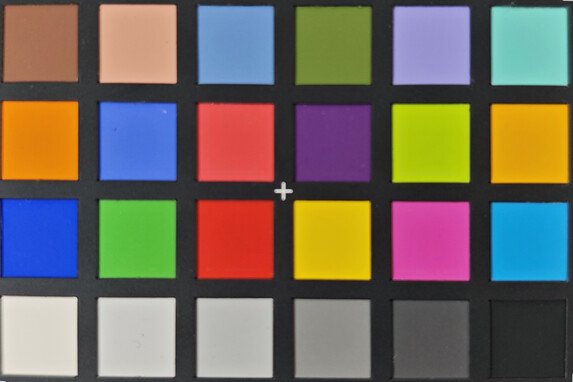
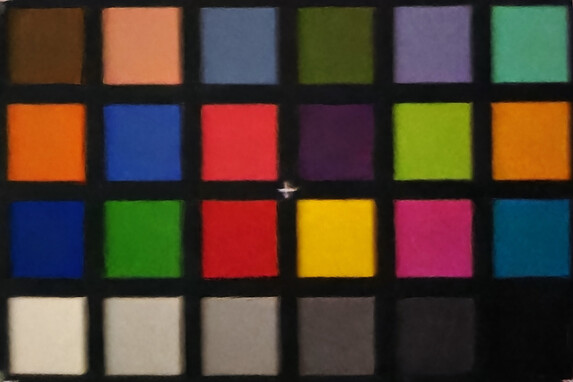
配件和保修 - 附送充电器的小米 14 Pro
输入设备和操作 - 配备光学指纹传感器的小米智能手机
显示屏 - 配备 OLED 显示屏的小米 14 Pro
内置的 2K AMOLED Super Visual Sense 显示屏达到了 WQHD+ 分辨率,像素密度高达 522 ppi。系统本身报告称,120Hz 动态显示屏的最低频率非常低,仅为 10 Hz,而制造商规定的频率为 1 Hz。
该面板使用了小米和 CSOT(TCL 公司)共同开发的 C8 照明材料,据称可提供业内最高的亮度。在播放 4K HDR 模式视频时,我们几乎达到了宣传的最高亮度 3,000 尼特,实际值为 2.882 cd/m²。
在纯白显示内容和激活亮度传感器的情况下,最大亮度为 1,076 cd/m²,但在亮暗区域均匀分布的情况下(APL18),14 Pro 的显示屏亮度更高,在我们的测试中达到 1,432 cd/m²。
| |||||||||||||||||||||||||
Brightness Distribution: 95 %
Center on Battery: 1025 cd/m²
Contrast: ∞:1 (Black: 0 cd/m²)
ΔE ColorChecker Calman: 1.1 | ∀{0.5-29.43 Ø4.78}
ΔE Greyscale Calman: 2.2 | ∀{0.09-98 Ø5}
99.4% sRGB (Calman 2D)
Gamma: 2.25
CCT: 6622 K
| Xiaomi 14 Pro AMOLED, 3200x1440, 6.7" | Samsung Galaxy S23+ Dynamic AMOLED 2x, 2340x1080, 6.6" | Google Pixel 8 Pro OLED, 2992x1344, 6.7" | Sony Xperia 5 V OLED, 2520x1080, 6.1" | Xiaomi 13 Pro OLED, 3200x1440, 6.7" | |
|---|---|---|---|---|---|
| Screen | -33% | 13% | -9% | 11% | |
| Brightness middle (cd/m²) | 1025 | 1128 10% | 1510 47% | 889 -13% | 1230 20% |
| Brightness (cd/m²) | 1046 | 1136 9% | 1467 40% | 898 -14% | 1244 19% |
| Brightness Distribution (%) | 95 | 99 4% | 92 -3% | 97 2% | 94 -1% |
| Black Level * (cd/m²) | |||||
| Colorchecker dE 2000 * | 1.1 | 2.7 -145% | 1.1 -0% | 1.4 -27% | 1 9% |
| Colorchecker dE 2000 max. * | 2.9 | 4.5 -55% | 3.8 -31% | 4.5 -55% | 2.8 3% |
| Greyscale dE 2000 * | 2.2 | 2.6 -18% | 1.7 23% | 1 55% | 1.8 18% |
| Gamma | 2.25 98% | 2.05 107% | 2.23 99% | 2.23 99% | 2.24 98% |
| CCT | 6622 98% | 6644 98% | 6670 97% | 6456 101% | 6446 101% |
* ... smaller is better
由于采用的是 OLED 技术,小米使用脉宽调制及其相应的显示闪烁来控制显示亮度。在我们使用示波器进行测量时,整个亮度范围内的振幅都非常均匀,在 120 Hz 时也非常稳定。不过,制造商在这里提到的频率非常高,达到了 1920 赫兹,这对于敏感的用户来说会更加舒适。为了了解更多相关信息,我们还使用闪烁计对小米 14 Pro 进行了检测,闪烁计可以识别照明密度的明显变化。通过测量 1,933 Hz 的频率,我们还能确认制造商的规格。
Screen Flickering / PWM (Pulse-Width Modulation)
| Screen flickering / PWM detected | 120.5 Hz | ||
The display backlight flickers at 120.5 Hz (worst case, e.g., utilizing PWM) . The frequency of 120.5 Hz is very low, so the flickering may cause eyestrain and headaches after extended use. In comparison: 53 % of all tested devices do not use PWM to dim the display. If PWM was detected, an average of 8098 (minimum: 5 - maximum: 343500) Hz was measured. | |||
在固定缩放级别和各种显示亮度设置下的测量系列
我们使用 Calman 分析软件和光光谱仪检查了杜比视界、HDR10+ 和 HGL 认证 AMOLED 面板(12 位)的色彩校准。色彩和灰度的偏差保持在目标范围内(<3),测得的 DeltaE 值非常低。
在调整选项方面,HyperOS 界面堪称典范。除了三种色彩配置文件外,用户还可以在扩展设置中调整色彩空间(sRGB、P3)、饱和度和伽玛值等单个参数。
Display Response Times
| ↔ Response Time Black to White | ||
|---|---|---|
| 1.5 ms ... rise ↗ and fall ↘ combined | ↗ 0.766 ms rise | |
| ↘ 0.736 ms fall | ||
| The screen shows very fast response rates in our tests and should be very well suited for fast-paced gaming. In comparison, all tested devices range from 0.1 (minimum) to 240 (maximum) ms. » 8 % of all devices are better. This means that the measured response time is better than the average of all tested devices (20.2 ms). | ||
| ↔ Response Time 50% Grey to 80% Grey | ||
| 1.36 ms ... rise ↗ and fall ↘ combined | ↗ 0.6685 ms rise | |
| ↘ 0.694 ms fall | ||
| The screen shows very fast response rates in our tests and should be very well suited for fast-paced gaming. In comparison, all tested devices range from 0.165 (minimum) to 636 (maximum) ms. » 5 % of all devices are better. This means that the measured response time is better than the average of all tested devices (31.6 ms). | ||
性能 - 配备骁龙芯片的小米智能手机
骁龙 8 代 3 骁龙 8 代 3小米 14 Pro 采用的是美国制造商 2024 年推出的高端 SoC。在我们的基准测试中,这款配备 12GB DDR5x 内存和 256GB UFS 4.0 快速存储的小米智能手机表现出了极高的性能水平。特别是在 Geekbench 的多核评估中,高通芯片组与 骁龙 8 代 2或 Apple A17 Pro.
另一方面,单核 CPU 性能却低于 iPhone 15 Pro.考虑到Apple A17 P 内核的时钟速度更高(3.8 GHz),我们预计会出现这种情况。在这里,Prime 内核(Cortex X4,3.3 GHz)的性能与前代产品相比仅略有提高。虽然 14 Pro 在系统基准测试(PCMark、CrossMark)中表现出色,但仍落后于 索尼 Xperia 5 V的 骁龙 8 代 2.
| UL Procyon AI Inference for Android - Overall Score NNAPI | |
| Google Pixel 8 Pro | |
| Average of class Smartphone (3769 - 81594, n=135, last 2 years) | |
| Xiaomi 14 Pro | |
| Samsung Galaxy S23+ | |
| Sony Xperia 5 V | |
| Average Qualcomm Snapdragon 8 Gen 3 (11487 - 18370, n=22) | |
| Xiaomi 13 Pro | |
在 GFXBench 图形测试中,配备 Adreno 750 处理器的小米 14 Pro Adreno 750领先于 三星Galaxy S23 Plus和 小米 13 Pro不出所料,但前提是在测试前没有任何负载情况。如果我们持续不间断地运行 GFXBench,结果有时会明显降低,这是由于高发热导致的暂时性性能下降。
GFXBench 3.0: on screen Manhattan Onscreen OGL | 1920x1080 1080p Manhattan Offscreen
GFXBench 3.1: on screen Manhattan ES 3.1 Onscreen | 1920x1080 Manhattan ES 3.1 Offscreen
GFXBench: on screen Car Chase Onscreen | 1920x1080 Car Chase Offscreen | on screen Aztec Ruins High Tier Onscreen | 2560x1440 Aztec Ruins High Tier Offscreen | on screen Aztec Ruins Normal Tier Onscreen | 1920x1080 Aztec Ruins Normal Tier Offscreen | 3840x2160 4K Aztec Ruins High Tier Offscreen
| GFXBench (DX / GLBenchmark) 2.7 / T-Rex Onscreen | |
| Xiaomi 13 Pro | |
| Samsung Galaxy S23+ | |
| Sony Xperia 5 V | |
| Google Pixel 8 Pro | |
| Xiaomi 14 Pro | |
| GFXBench (DX / GLBenchmark) 2.7 / T-Rex Offscreen | |
| Xiaomi 14 Pro | |
| Xiaomi 13 Pro | |
| Samsung Galaxy S23+ | |
| Sony Xperia 5 V | |
| Google Pixel 8 Pro | |
| GFXBench 3.0 / Manhattan Onscreen OGL | |
| Xiaomi 13 Pro | |
| Samsung Galaxy S23+ | |
| Sony Xperia 5 V | |
| Google Pixel 8 Pro | |
| Xiaomi 14 Pro | |
| GFXBench 3.0 / 1080p Manhattan Offscreen | |
| Xiaomi 14 Pro | |
| Xiaomi 13 Pro | |
| Sony Xperia 5 V | |
| Samsung Galaxy S23+ | |
| Google Pixel 8 Pro | |
| GFXBench 3.1 / Manhattan ES 3.1 Onscreen | |
| Samsung Galaxy S23+ | |
| Sony Xperia 5 V | |
| Xiaomi 14 Pro | |
| Google Pixel 8 Pro | |
| Xiaomi 13 Pro | |
| GFXBench 3.1 / Manhattan ES 3.1 Offscreen | |
| Xiaomi 14 Pro | |
| Xiaomi 13 Pro | |
| Samsung Galaxy S23+ | |
| Sony Xperia 5 V | |
| Google Pixel 8 Pro | |
| GFXBench / Car Chase Onscreen | |
| Samsung Galaxy S23+ | |
| Sony Xperia 5 V | |
| Xiaomi 14 Pro | |
| Google Pixel 8 Pro | |
| Xiaomi 13 Pro | |
| GFXBench / Car Chase Offscreen | |
| Xiaomi 14 Pro | |
| Samsung Galaxy S23+ | |
| Xiaomi 13 Pro | |
| Sony Xperia 5 V | |
| Google Pixel 8 Pro | |
| GFXBench / Aztec Ruins High Tier Onscreen | |
| Samsung Galaxy S23+ | |
| Sony Xperia 5 V | |
| Xiaomi 14 Pro | |
| Google Pixel 8 Pro | |
| Xiaomi 13 Pro | |
| GFXBench / Aztec Ruins High Tier Offscreen | |
| Xiaomi 14 Pro | |
| Samsung Galaxy S23+ | |
| Xiaomi 13 Pro | |
| Sony Xperia 5 V | |
| Google Pixel 8 Pro | |
| GFXBench / Aztec Ruins Normal Tier Onscreen | |
| Samsung Galaxy S23+ | |
| Sony Xperia 5 V | |
| Xiaomi 14 Pro | |
| Google Pixel 8 Pro | |
| Xiaomi 13 Pro | |
| GFXBench / Aztec Ruins Normal Tier Offscreen | |
| Xiaomi 14 Pro | |
| Samsung Galaxy S23+ | |
| Xiaomi 13 Pro | |
| Sony Xperia 5 V | |
| Google Pixel 8 Pro | |
| GFXBench / 4K Aztec Ruins High Tier Offscreen | |
| Xiaomi 14 Pro | |
| Samsung Galaxy S23+ | |
| Sony Xperia 5 V | |
| Xiaomi 13 Pro | |
| Google Pixel 8 Pro | |
小米智能手机的浏览器性能非常好,冲浪不会给 14 Pro 带来任何问题。在我们的基准测试包中,徕卡智能手机有时能达到最高值,但总体上处于中游水平。
| Jetstream 2 - 2.0 Total Score | |
| Sony Xperia 5 V (Chrome 117.0.5938.60) | |
| Samsung Galaxy S23+ (Chrome 110.0.5481.65) | |
| Xiaomi 14 Pro (Chrome 120) | |
| Average Qualcomm Snapdragon 8 Gen 3 (64.1 - 241, n=24) | |
| Average of class Smartphone (23.8 - 387, n=149, last 2 years) | |
| Xiaomi 13 Pro (Chrome 109) | |
| Google Pixel 8 Pro (Chrome 117) | |
| Speedometer 2.0 - Result 2.0 | |
| Average of class Smartphone (15.2 - 643, n=122, last 2 years) | |
| Average Qualcomm Snapdragon 8 Gen 3 (69.6 - 311, n=19) | |
| Sony Xperia 5 V (Chrome 117.0.5938.60) | |
| Google Pixel 8 Pro (Chrome 117) | |
| Samsung Galaxy S23+ (Chrome 110.0.5481.65) | |
| Xiaomi 14 Pro (Chrome 120) | |
| Xiaomi 13 Pro (Chrome 109) | |
| WebXPRT 4 - Overall | |
| Xiaomi 14 Pro (Chrome 120) | |
| Sony Xperia 5 V (Chrome 117.0.5938.60) | |
| Average Qualcomm Snapdragon 8 Gen 3 (69 - 212, n=22) | |
| Xiaomi 13 Pro (Chrome 109) | |
| Samsung Galaxy S23+ (Chrome 110.0.5481.65) | |
| Average of class Smartphone (27 - 306, n=145, last 2 years) | |
| Google Pixel 8 Pro (Chrome 117) | |
| WebXPRT 3 - Overall | |
| Sony Xperia 5 V (Chrome 117.0.5938.60) | |
| Average Qualcomm Snapdragon 8 Gen 3 (142 - 310, n=9) | |
| Xiaomi 14 Pro (Chrome 120) | |
| Average of class Smartphone (38 - 380, n=31, last 2 years) | |
| Google Pixel 8 Pro (Chrome 117) | |
| Octane V2 - Total Score | |
| Sony Xperia 5 V (Chrome 117.0.5938.60) | |
| Samsung Galaxy S23+ (Chrome 110.0.5481.65) | |
| Xiaomi 14 Pro (Chrome 120) | |
| Average Qualcomm Snapdragon 8 Gen 3 (25953 - 75238, n=27) | |
| Google Pixel 8 Pro (Chrome 117) | |
| Average of class Smartphone (2228 - 121337, n=197, last 2 years) | |
| Xiaomi 13 Pro (Chrome 109) | |
| Mozilla Kraken 1.1 - Total | |
| Average of class Smartphone (257 - 28190, n=155, last 2 years) | |
| Google Pixel 8 Pro (Chrome 117) | |
| Xiaomi 14 Pro (Chrome 120) | |
| Average Qualcomm Snapdragon 8 Gen 3 (510 - 2066, n=25) | |
| Sony Xperia 5 V (Chrome 117.0.5938.60) | |
| Samsung Galaxy S23+ (Chrome 110.0.5481.65) | |
| Xiaomi 13 Pro (Chrome 109) | |
* ... smaller is better
| Xiaomi 14 Pro Adreno 750, SD 8 Gen 3, 256 GB UFS 4.0 Flash | Xiaomi 13 Pro Adreno 740, SD 8 Gen 2, 256 GB UFS 4.0 Flash | |
|---|---|---|
| PCMark for Android | 90% | |
| Storage 2.0 random write int. (MB/s) | 28 | 84.97 203% |
| Storage 2.0 seq. write int. (MB/s) | 2300 | 2299.5 0% |
| Storage 2.0 random read int. (MB/s) | 20.9 | 45.22 116% |
| Storage 2.0 seq. read int. (MB/s) | 2075 | 2926.49 41% |
游戏 - 小米智能手机达到 100 帧或更高
使用GameBench应用程序,我们可以更近距离地了解 Play Store 中游戏的运行流畅度,以及小米 14 Pro 是否可以运行 HFR 游戏。虽然后者在我们的测试中正常运行,但只能在《死亡扳机 2》等较老的游戏中实现。
在《PUBG Mobile》中,中等细节(高清模式)下可以持续达到通常的 60 帧/秒,而当我们在测试中增加图形细节(UHD)时,显卡甚至还能达到 40 帧/秒。最近推出的 90 帧选项并未显示,这可能是由于Android 14 和应用程序配置不足造成的。要求极高的《源氏冲击》奇幻动作角色游戏的最高重现速度为 60 帧/秒。
排放 - 高发热量的小米 14 Pro
温度
在小米 14 Pro 的市场介绍中,小米强调其散热系统的效率明显高于 iPhone 15 Pro Max的散热系统效率要高得多,使其能够在持续负载下实现更高的性能。我们无法研究 骁龙 8 代 3在性能热节流方面,我们无法通过 3DMark 的压力测试来检验骁龙 8 代 3 的性能表现,因为在我们的测试期间无法进行安装。但 GFXBench 的基准测试结果(见上文)至少表明,有时性能表现并不稳定。
在我们的测量中,表面温度相当高,特别是考虑到 "Burnout Benchmark "是在 CPU 和 GPU 满载的情况下因过热而终止的。这也意味着我们对发热量的测量仅在较容易的条件下(CPU)进行。
(±) The maximum temperature on the upper side is 44.6 °C / 112 F, compared to the average of 35.2 °C / 95 F, ranging from 21.9 to 247 °C for the class Smartphone.
(±) The bottom heats up to a maximum of 44.2 °C / 112 F, compared to the average of 34 °C / 93 F
(+) In idle usage, the average temperature for the upper side is 26.6 °C / 80 F, compared to the device average of 32.9 °C / 91 F.
3DMark Wild Life Stress Test
| 3DMark | |
| Wild Life Stress Test Stability | |
| Xiaomi 13 Pro | |
| Google Pixel 8 Pro | |
| Samsung Galaxy S23+ | |
| Sony Xperia 5 V | |
| Wild Life Extreme Stress Test | |
| Xiaomi 13 Pro | |
| Google Pixel 8 Pro | |
| Samsung Galaxy S23+ | |
| Sony Xperia 5 V | |
发言人
小米 14 Pro 采用双扬声器系统,音量很大。我们测得的最大音量超过 90 分贝。虽然我们能感受到轻微的低音,但小米智能手机无法提供具有一定存在感的低频。我们的粉红噪声测量结果显示,中频的频率曲线略有上升。
希望使用外部声音输出的用户可以使用 USB 进行有线连接,或使用蓝牙 5.4 进行无线连接。后者支持 SBC、AAC、aptX、aptX HD、aptX Adaptive、aptX TWS+、LDAC 和 LHDC V5 编解码器。不支持 LC3 和 aptX Lossless。
Xiaomi 14 Pro audio analysis
(+) | speakers can play relatively loud (90.5 dB)
Bass 100 - 315 Hz
(-) | nearly no bass - on average 21.5% lower than median
(±) | linearity of bass is average (7.3% delta to prev. frequency)
Mids 400 - 2000 Hz
(+) | balanced mids - only 4.7% away from median
(+) | mids are linear (6% delta to prev. frequency)
Highs 2 - 16 kHz
(±) | higher highs - on average 5.3% higher than median
(+) | highs are linear (4.9% delta to prev. frequency)
Overall 100 - 16.000 Hz
(±) | linearity of overall sound is average (16% difference to median)
Compared to same class
» 5% of all tested devices in this class were better, 4% similar, 91% worse
» The best had a delta of 11%, average was 35%, worst was 134%
Compared to all devices tested
» 24% of all tested devices were better, 5% similar, 70% worse
» The best had a delta of 4%, average was 24%, worst was 134%
Xiaomi 13 Pro audio analysis
(+) | speakers can play relatively loud (88.5 dB)
Bass 100 - 315 Hz
(-) | nearly no bass - on average 21.7% lower than median
(±) | linearity of bass is average (8.6% delta to prev. frequency)
Mids 400 - 2000 Hz
(+) | balanced mids - only 3.8% away from median
(+) | mids are linear (5.1% delta to prev. frequency)
Highs 2 - 16 kHz
(+) | balanced highs - only 4.8% away from median
(+) | highs are linear (3.8% delta to prev. frequency)
Overall 100 - 16.000 Hz
(±) | linearity of overall sound is average (15.6% difference to median)
Compared to same class
» 4% of all tested devices in this class were better, 3% similar, 93% worse
» The best had a delta of 11%, average was 35%, worst was 134%
Compared to all devices tested
» 23% of all tested devices were better, 4% similar, 73% worse
» The best had a delta of 4%, average was 24%, worst was 134%
电池续航时间 - 配备无线充电功能的小米智能手机
耗电量
小米 14 Pro 配备 4880 毫安时电池,充电功率最高可达 120 瓦。使用无线充电时,最大功率为 50 瓦,反向无线充电最大功率为 10 瓦。在我们的测试中,这款高端智能手机完全放电后在充电器上需要大约 20 分钟。幸运的是,包装盒中附带了一个足够快的充电器。
考虑到面板的高分辨率,14 Pro 闲置时的功耗约为 1 瓦,堪称典范。而从 Burnout 基准测试来看,负载情况下的功耗也很低。使用新的设置,其他智能手机如 混合折叠 3达到的数值几乎是它的两倍。
| Off / Standby | |
| Idle | |
| Load |
|
Key:
min: | |
| Xiaomi 14 Pro 4880 mAh | Samsung Galaxy S23+ 4700 mAh | Google Pixel 8 Pro 5050 mAh | Sony Xperia 5 V 5000 mAh | Xiaomi 13 Pro 4820 mAh | Xiaomi Mix Fold 3 4800 mAh | Average Qualcomm Snapdragon 8 Gen 3 | Average of class Smartphone | |
|---|---|---|---|---|---|---|---|---|
| Power Consumption | 28% | -8% | 4% | -1% | -32% | -35% | -16% | |
| Idle Minimum * (Watt) | 0.89 | 0.64 28% | 0.63 29% | 0.79 11% | 1.02 -15% | 0.86 3% | 0.969 ? -9% | 0.842 ? 5% |
| Idle Average * (Watt) | 1.05 | 0.88 16% | 1.47 -40% | 1.08 -3% | 1.36 -30% | 1.05 -0% | 1.721 ? -64% | 1.439 ? -37% |
| Idle Maximum * (Watt) | 1.11 | 0.94 15% | 1.55 -40% | 1.12 -1% | 1.58 -42% | 1.07 4% | 1.891 ? -70% | 1.624 ? -46% |
| Load Average * (Watt) | 9.03 | 4.18 54% | 8.45 6% | 7.93 12% | 4.29 52% | 15.27 -69% | 8.91 ? 1% | 7.03 ? 22% |
| Load Maximum * (Watt) | 9.06 | 6.59 27% | 8.63 5% | 8.78 3% | 6.15 32% | 17.78 -96% | 12.1 ? -34% | 11.3 ? -25% |
* ... smaller is better
Power Consumption: Geekbench (150 cd/m²)
Power Consumption: GFXBench (150 cd/m²)
电池寿命
在调整显示屏亮度为 150 cd/m² 的情况下,14 Pro 的电池在 WLAN 测试中的实际 WiFi 电池测试时间为 15 小时。在关闭 WLAN 模块播放视频时,小米智能手机的续航时间约为 24 小时,这也表明该手机的通信模块并没有得到很好的优化。
| Xiaomi 14 Pro 4880 mAh | Samsung Galaxy S23+ 4700 mAh | Google Pixel 8 Pro 5050 mAh | Sony Xperia 5 V 5000 mAh | Xiaomi 13 Pro 4820 mAh | |
|---|---|---|---|---|---|
| Battery runtime | 42% | -14% | 36% | -3% | |
| Reader / Idle (h) | 33.3 | 43.1 29% | 22.4 -33% | 46.5 40% | 25.2 -24% |
| H.264 (h) | 24 | 25.4 6% | 18.7 -22% | 24.9 4% | 21.1 -12% |
| WiFi v1.3 (h) | 15 | 19.9 33% | 12.7 -15% | 15.9 6% | 14.1 -6% |
| Load (h) | 3.2 | 6.4 100% | 3.7 16% | 6.2 94% | 4.2 31% |
Pros
Cons
小米 14 Pro 的评价
小米 14 Pro 解决了前代产品的几个弱点 前代(自拍质量不足、缺少 UHD 选项和 USB 2.0 等),并提供了一个强大的整体解决方案。不过,完全更新的主摄像头和可变光圈在我们的测试中留下了一些悬而未决的问题。考虑到强大的 照片和 视频质量的 小米 13 Ultra从短期来看,对 IMX989 进行一些额外的优化可能会是更好的选择。另一个悬而未决的问题是,小米 14 Pro 是否会在 2024 年初全球上市。
在我们的测试中,这款目前的小米旗舰产品采用了非常明亮和精确的 LTPO 显示屏,最大亮度接近 3,000 cd/m²,令人信服。我们也非常喜欢其圆润的外形。如果你不喜欢 WQHD+ 的高分辨率,可以选择电池续航时间更长的 1,080p 显示屏。 Galaxy S23 Plus.其他可能的替代品是 谷歌 Pixel 8 Pro或 小米 13T Pro.
小米 14 Pro 还需要进一步改进,才能充分发挥其潜力。
14 Pro 不得不接受一些关于其 SoC 散热能力较弱的批评。在基准测试中,小米智能手机的发热量导致原本非常强大的Snapdragon 8 Gen 3 表现参差不齐。在购买之前,您还应考虑到中国版本的频段覆盖范围较小。
价格和供应情况
小米 14 Pro 目前只能以进口设备的形式销售,例如从深圳贸易公司购买,起价约为 864 美元。
Xiaomi 14 Pro
- 12/29/2023 v7 (old)
Marcus Herbrich
Transparency
The selection of devices to be reviewed is made by our editorial team. The test sample was provided to the author as a loan by the manufacturer or retailer for the purpose of this review. The lender had no influence on this review, nor did the manufacturer receive a copy of this review before publication. There was no obligation to publish this review. As an independent media company, Notebookcheck is not subjected to the authority of manufacturers, retailers or publishers.
This is how Notebookcheck is testing
Every year, Notebookcheck independently reviews hundreds of laptops and smartphones using standardized procedures to ensure that all results are comparable. We have continuously developed our test methods for around 20 years and set industry standards in the process. In our test labs, high-quality measuring equipment is utilized by experienced technicians and editors. These tests involve a multi-stage validation process. Our complex rating system is based on hundreds of well-founded measurements and benchmarks, which maintains objectivity. Further information on our test methods can be found here.




